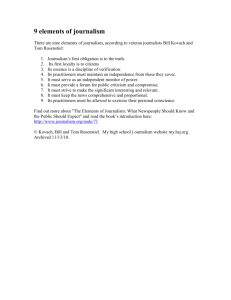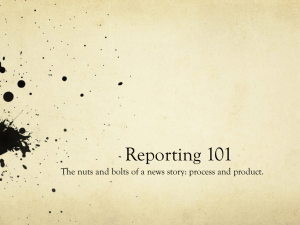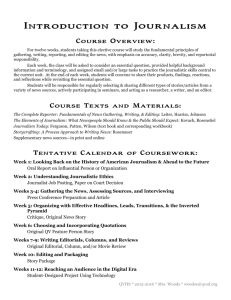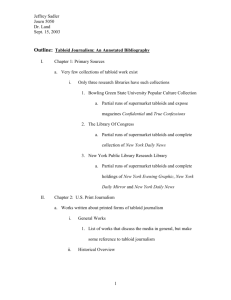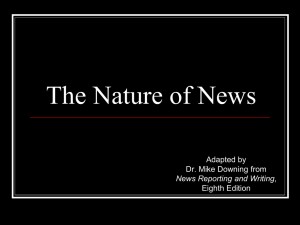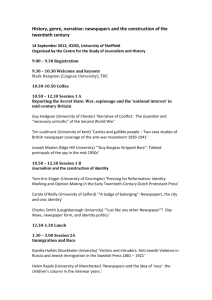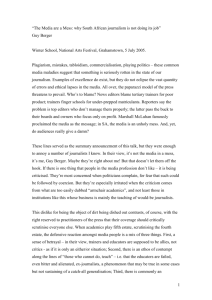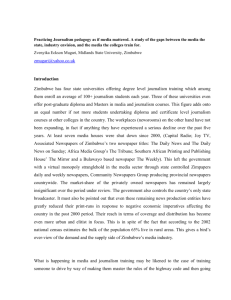Taking the gap
advertisement
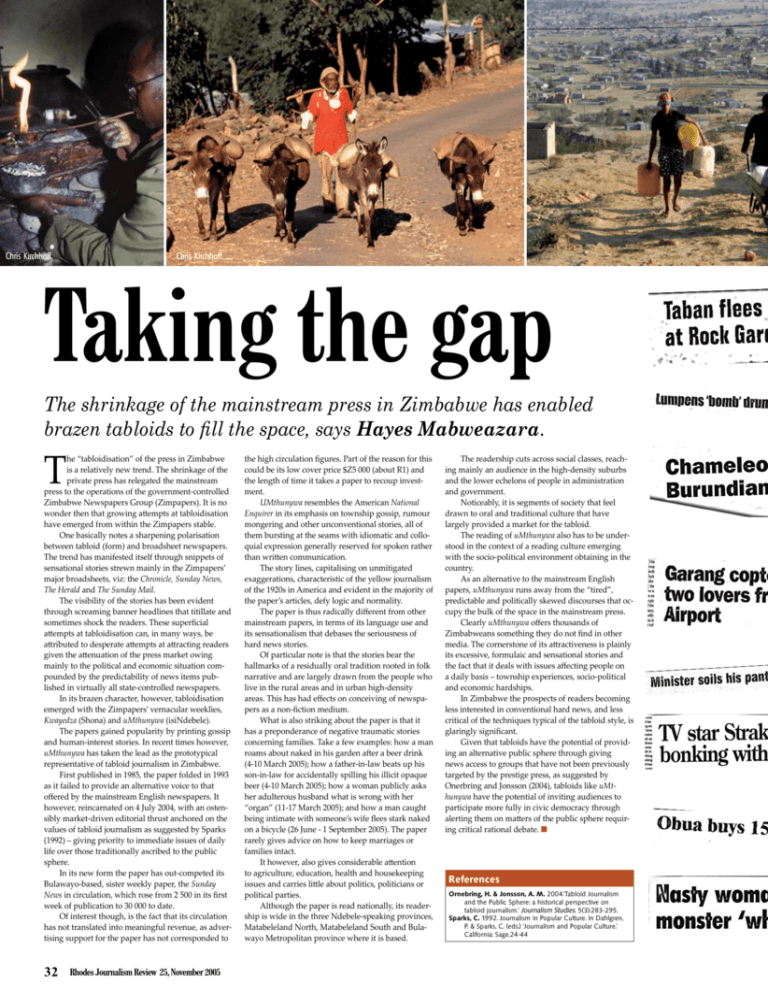
Chris Kirchhoff Chris Kirchhoff Taking the gap The shrinkage of the mainstream press in Zimbabwe has enabled brazen tabloids to fill the space, says Hayes Mabweazara. T he “tabloidisation” of the press in Zimbabwe is a relatively new trend. The shrinkage of the private press has relegated the mainstream press to the operations of the government-controlled Zimbabwe Newspapers Group (Zimpapers). It is no wonder then that growing attempts at tabloidisation have emerged from within the Zimpapers stable. One basically notes a sharpening polarisation between tabloid (form) and broadsheet newspapers. The trend has manifested itself through snippets of sensational stories strewn mainly in the Zimpapers’ major broadsheets, viz: the Chronicle, Sunday News, The Herald and The Sunday Mail. The visibility of the stories has been evident through screaming banner headlines that titillate and sometimes shock the readers. These superficial attempts at tabloidisation can, in many ways, be attributed to desperate attempts at attracting readers given the attenuation of the press market owing mainly to the political and economic situation compounded by the predictability of news items published in virtually all state-controlled newspapers. In its brazen character, however, tabloidisation emerged with the Zimpapers’ vernacular weeklies, Kwayedza (Shona) and uMthunywa (isiNdebele). The papers gained popularity by printing gossip and human-interest stories. In recent times however, uMthunywa has taken the lead as the prototypical representative of tabloid journalism in Zimbabwe. First published in 1985, the paper folded in 1993 as it failed to provide an alternative voice to that offered by the mainstream English newspapers. It however, reincarnated on 4 July 2004, with an ostensibly market-driven editorial thrust anchored on the values of tabloid journalism as suggested by Sparks (1992) – giving priority to immediate issues of daily life over those traditionally ascribed to the public sphere. In its new form the paper has out-competed its Bulawayo-based, sister weekly paper, the Sunday News in circulation, which rose from 2 500 in its first week of publication to 30 000 to date. Of interest though, is the fact that its circulation has not translated into meaningful revenue, as advertising support for the paper has not corresponded to 32 Rhodes Journalism Review 25, November 2005 the high circulation figures. Part of the reason for this could be its low cover price $Z5 000 (about R1) and the length of time it takes a paper to recoup investment. UMthunywa resembles the American National Enquirer in its emphasis on township gossip, rumour mongering and other unconventional stories, all of them bursting at the seams with idiomatic and colloquial expression generally reserved for spoken rather than written communication. The story lines, capitalising on unmitigated exaggerations, characteristic of the yellow journalism of the 1920s in America and evident in the majority of the paper’s articles, defy logic and normality. The paper is thus radically different from other mainstream papers, in terms of its language use and its sensationalism that debases the seriousness of hard news stories. Of particular note is that the stories bear the hallmarks of a residually oral tradition rooted in folk narrative and are largely drawn from the people who live in the rural areas and in urban high-density areas. This has had effects on conceiving of newspapers as a non-fiction medium. What is also striking about the paper is that it has a preponderance of negative traumatic stories concerning families. Take a few examples: how a man roams about naked in his garden after a beer drink (4-10 March 2005); how a father-in-law beats up his son-in-law for accidentally spilling his illicit opaque beer (4-10 March 2005); how a woman publicly asks her adulterous husband what is wrong with her “organ” (11-17 March 2005); and how a man caught being intimate with someone’s wife flees stark naked on a bicycle (26 June - 1 September 2005). The paper rarely gives advice on how to keep marriages or families intact. It however, also gives considerable attention to agriculture, education, health and housekeeping issues and carries little about politics, politicians or political parties. Although the paper is read nationally, its readership is wide in the three Ndebele-speaking provinces, Matabeleland North, Matabeleland South and Bulawayo Metropolitan province where it is based. The readership cuts across social classes, reaching mainly an audience in the high-density suburbs and the lower echelons of people in administration and government. Noticeably, it is segments of society that feel drawn to oral and traditional culture that have largely provided a market for the tabloid. The reading of uMthunywa also has to be understood in the context of a reading culture emerging with the socio-political environment obtaining in the country. As an alternative to the mainstream English papers, uMthunywa runs away from the “tired”, predictable and politically skewed discourses that occupy the bulk of the space in the mainstream press. Clearly uMthunywa offers thousands of Zimbabweans something they do not find in other media. The cornerstone of its attractiveness is plainly its excessive, formulaic and sensational stories and the fact that it deals with issues affecting people on a daily basis – township experiences, socio-political and economic hardships. In Zimbabwe the prospects of readers becoming less interested in conventional hard news, and less critical of the techniques typical of the tabloid style, is glaringly significant. Given that tabloids have the potential of providing an alternative public sphere through giving news access to groups that have not been previously targeted by the prestige press, as suggested by Onerbring and Jonsson (2004), tabloids like uMthunywa have the potential of inviting audiences to participate more fully in civic democracy through alerting them on matters of the public sphere requiring critical rational debate. References Ornebring, H. & Jonsson, A. M. 2004.’Tabloid Journalism and the Public Sphere: a historical perspective on tabloid journalism.’ Journalism Studies. 5(3):283-295. Sparks, C. 1992. Journalism in Popular Culture. In Dahlgren, P. & Sparks, C. (eds.) ‘Journalism and Popular Culture.’ California: Sage.24-44


